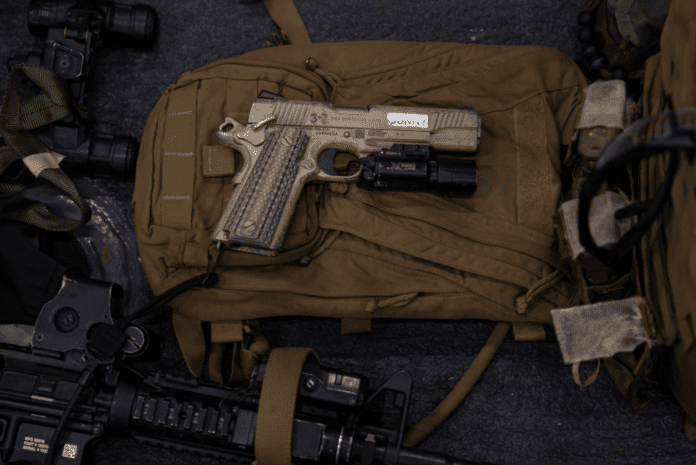
Choosing the right caliber for self-defense can be daunting, especially with so many options available. One round that consistently stands out is the .45 ACP. Trusted for over a century by military personnel, law enforcement and civilians, the .45 ACP has earned its reputation for delivering powerful stopping power in critical moments. But is it the best option for protecting yourself and your loved ones?
Let’s break down the key advantages of the .45 ACP for self-defense, addressing common concerns like capacity and recoil, while highlighting why it remains a go-to choice for many experts. Whether new to firearms or a seasoned shooter, you’ll learn how this trusted round can enhance your personal protection.
The History of the .45 ACP
The .45 ACP has a rich and compelling history that adds to its appeal as a self-defense round. Developed in 1905 by the legendary firearms designer John Moses Browning, the .45 ACP was created to meet the U.S. military’s need for a more powerful sidearm. The result was a round providing significantly more stopping power than its predecessors. This led to adopting the M1911, a .45 ACP handgun, which became a staple for the U.S. military from World War I through Vietnam and beyond.
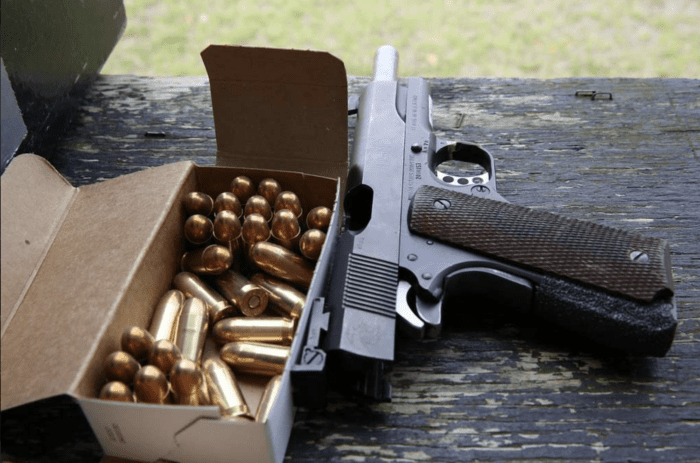
The .45 ACP’s battlefield performance solidified its reputation as a hard-hitting, reliable round that could neutralize threats with minimal shots. Its larger, slower-moving bullet made it particularly effective at close range, where self-defense situations often occur. Despite the rise of smaller, higher-velocity rounds like the 9mm, the .45 ACP has maintained popularity due to its historical success in real-world combat scenarios.
Stopping Power: The Main Advantage of the 45 ACP
When discussing self-defense calibers, the term “stopping power” is often a key consideration, and the .45 ACP is renowned for its ability to stop threats quickly. The cartridge typically fires a larger and heavier bullet weighing 185 to 230 grains, which transfers significant energy upon impact. This energy transfer can incapacitate an assailant more effectively than smaller, faster rounds. This stopping power can be critical in life-threatening situations where the goal is to neutralize the threat as quickly as possible.
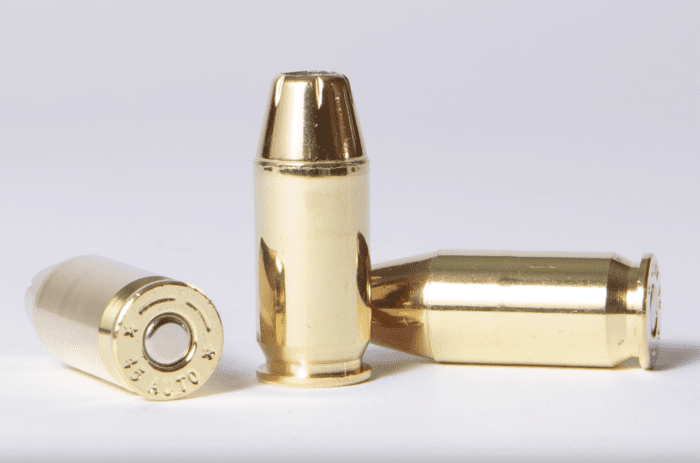 (Photo: HOP Munitions – 230 grain JHP)
(Photo: HOP Munitions – 230 grain JHP)The .45 ACP’s larger diameter also creates a wider wound channel, causing more tissue damage. This often leads to faster incapacitation, even if only one or two rounds are fired. Many proponents of the .45 ACP argue that it requires fewer shots to stop a threat than smaller calibers like the 9mm, making it a strong candidate for personal defense.
Moreover, modern ammunition advancements, such as jacketed hollow points (JHP), have further enhanced the stopping power of the .45 ACP. These rounds are designed to expand upon impact, reducing the risk of over-penetration and increasing the likelihood of the round staying within the target—an important factor in self-defense to avoid unintended harm.
Accuracy and Controllability
While the .45 ACP is known for its stopping power, it also offers a surprising level of accuracy and controllability, making it a solid choice for self-defense. One might assume that a larger, heavier round would produce excessive recoil, but this isn’t always true. The .45 ACP operates at a relatively low muzzle velocity (typically around 830 feet per second for a 230-grain bullet), which helps manage recoil and makes it easier for the shooter to stay on target.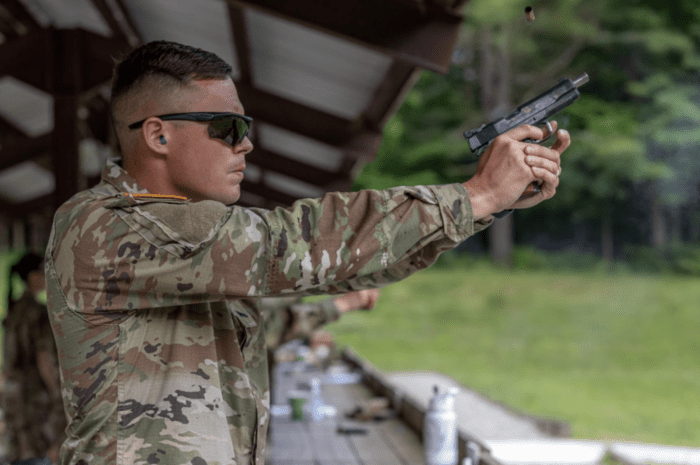
For many shooters, especially those with experience, the .45 ACP can feel more controllable compared to smaller, faster rounds like the 9mm. The slower recoil impulse allows for better follow-up shots, a critical factor in self-defense scenarios where accuracy and quick reaction times are essential.
Additionally, many .45 ACP pistols are built with ergonomics and weight distribution in mind, further aiding in recoil control. Guns like the 1911, a popular platform for the .45 ACP, are often praised for their balance, which can help shooters maintain precision even under stressful situations.
While novice shooters may initially find the .45 ACP’s recoil more challenging, proper training can mitigate this concern. Once a shooter is accustomed to the feel of the .45 ACP, they often appreciate its manageable recoil and accuracy at close to medium distances, the most common ranges for self-defense encounters.
Reliability: Trusted for Self-Defense
Reliability is one of the most critical factors when choosing a self-defense caliber, and the .45 ACP shines. Whether used in military, law enforcement, or civilian applications, the .45 ACP has a proven track record of dependable performance. In high-stress, life-or-death situations, the last thing you want is a firearm malfunction, and the .45 ACP’s reputation for reliability makes it a trustworthy choice.
One reason for this reliability is the round’s low-pressure design, which helps reduce wear and tear on firearms. Many pistols chambered in .45 ACP, such as the iconic 1911, or modern polymer-frame handguns like the Glock 21, are designed to be durable. These handguns are tested rigorously to ensure they function consistently, even in harsh conditions. This is why many law enforcement officers and military personnel have relied on .45 ACP pistols for decades.
Additionally, the wide variety of ammunition types available for the .45 ACP adds to its reliability. Whether using full metal jacket (FMJ) rounds for practice or jacketed hollow points (JHP) for personal defense, you can find a reliable load that functions well in your firearm. Modern ammunition manufacturers have optimized .45 ACP rounds to ensure smooth feeding, reduced misfires, and enhanced performance, making them a round you can count on when it matters most.
Addressing Common Criticisms: Capacity and Recoil
While the .45 ACP offers many benefits, a few common criticisms are often raised when discussing its suitability for self-defense—primarily its lower capacity and higher recoil compared to smaller calibers like the 9mm.
Magazine Capacity
One of the main trade-offs of carrying a .45 ACP handgun is its reduced magazine capacity. Due to the larger size of the .45 ACP round, most handguns chambered for it hold fewer rounds per magazine. For example, a standard 9mm pistol might hold 15 to 17 rounds, while a .45 ACP pistol typically holds between 7 and 10 rounds.
However, it’s important to note that the need for high capacity can be mitigated with proper training and practice. In many self-defense situations, accuracy and shot placement are far more important than the number of rounds. With the stopping power of the .45 ACP, fewer rounds may be needed to neutralize a threat. Many modern pistols, like the Glock 21, offer extended magazines, bridging the capacity gap between .45 ACP and 9mm handguns.
Recoil
Recoil is another factor that often deters some shooters from using the .45 ACP. The larger round produces more felt recoil than a 9mm, which can be intimidating for novice shooters. However, this disadvantage can be overcome with training. Many experienced shooters find the recoil of the .45 ACP to be manageable, especially when using pistols designed with recoil mitigation features.
The relatively slow velocity of the .45 ACP, combined with modern advancements in handgun design, has made it easier for shooters to maintain control and fire accurate follow-up shots. Guns with recoil springs, weight distribution and ergonomic grips help manage the recoil and keep the firearm on target.
Shooters Weigh in on using .45 ACP for Self Defense
The .45 ACP has been a popular self-defense round for decades, but opinions on its effectiveness and practicality vary widely. Here’s a look at what experienced shooters and firearms enthusiasts think about using the .45 ACP for self-defense, based on real-world feedback.
Training and Familiarity Matter More Than Caliber
One consistent theme among users is that your proficiency with a firearm is more important than the caliber. As one person put it, “If you can shoot it often enough to get good with it, then caliber becomes less important as training and skill increase.” This sentiment underscores that practice and familiarity with your chosen firearm will have a greater impact on self-defense outcomes than whether you’re using a .45 ACP or a 9mm.
Capacity and Ammunition Availability
While .45 ACP is seen as effective, many users highlight its limitations in capacity compared to 9mm. A .45 ACP handgun typically holds fewer rounds, which can be a concern in high-stress self-defense scenarios. As one user noted, “You’ll have less ammo in the mag than a similarly sized 9mm, and ammo to train with will be more expensive”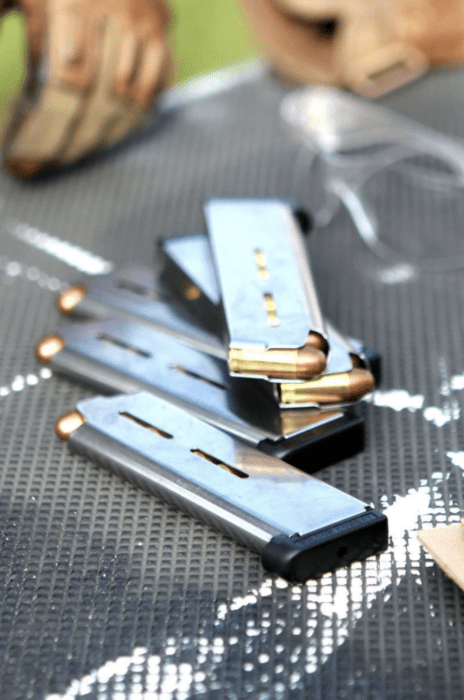 Magazines of .45-Caliber rounds are layed out as they are loaded during an exercise for Special Reaction Team, Provost Marshal’s Office, Marine Corps Air Station Beaufort, Aug. 21. The exercise was intended to familiarize the Marines of the team with the M45 1911 A1 pistol as they transition over from the standard issue Beretta M9A1 pistol.
Magazines of .45-Caliber rounds are layed out as they are loaded during an exercise for Special Reaction Team, Provost Marshal’s Office, Marine Corps Air Station Beaufort, Aug. 21. The exercise was intended to familiarize the Marines of the team with the M45 1911 A1 pistol as they transition over from the standard issue Beretta M9A1 pistol.
Ballistics and “Bigger Holes”
One of the selling points of the .45 ACP is its ability to create larger wounds due to its larger diameter bullet. However, modern advancements in ballistics have narrowed the gap between the effectiveness of different calibers. One experienced user explained, “I used to be way into .45 ACP because, as people like to say, ‘it makes bigger holes.’ But most modern handgun cartridges have very similar ballistics“
The Role of Overpenetration
Concerns about overpenetration are common in home defense. One shooter remarked that the .45 ACP’s slower velocity could make it less likely to penetrate walls or other barriers, making it a safer choice in some situations
Suppression and Recoil Considerations
The naturally subsonic nature of .45 ACP rounds makes them a popular choice for suppressed firearms, with some users specifically mentioning their preference for .45 ACP in home defense setups that include a suppressor
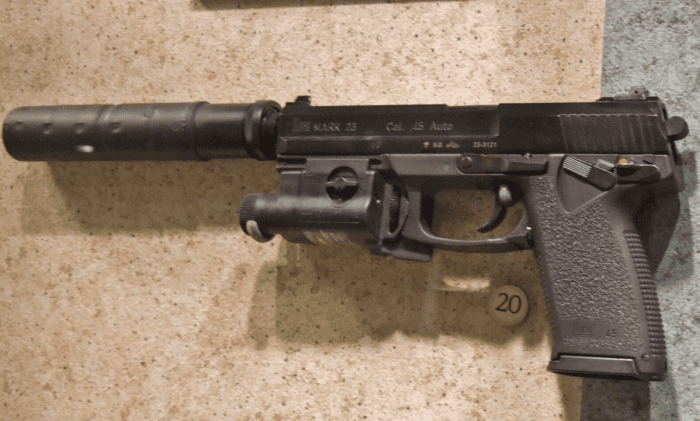 Heckler & Koch Mark 23 .45 cal SOCOM pistol (Photo: Creative Commons)
Heckler & Koch Mark 23 .45 cal SOCOM pistol (Photo: Creative Commons)Overall, the .45 ACP is still considered a viable self-defense option, especially for those familiar with and confident in using the caliber. However, for many, the higher capacity, lower recoil, and cheaper training costs of 9mm handguns make them the preferred choice for everyday carry and home defense. As one user put it, “Regardless of which is actually better, how well it’s used is going to be vastly more important“
It remains a solid self-defense option for those comfortable with the .45 ACP and willing to practice regularly. However, modern 9mm offerings provide capacity, recoil management, and affordability advantages, making them a more well-rounded choice for most situations.
Why the 45 ACP Is a Strong Choice for Self-Defense
When it comes to self-defense, choosing the right caliber is essential, and the .45 ACP makes a strong case for itself. Its combination of historical reliability, stopping power and accuracy makes it one of the most trusted rounds for personal protection. While the criticisms regarding magazine capacity and recoil are valid, they are manageable with the right training and firearm selection. For those prioritizing a proven round that can quickly stop a threat, the .45 ACP remains a top contender.
Ultimately, the best self-defense round is the one you feel most comfortable and confident with, but the .45 ACP offers a balance of power and performance that few other calibers can match. With modern advancements in ammunition and firearm design, the .45 ACP continues to evolve, making it an even more formidable option for those looking to protect themselves and their loved ones.